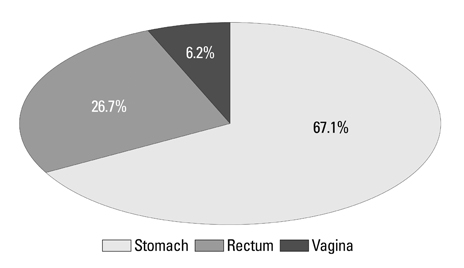Yonsei Med J.
2012 Sep;53(5):960-967.
Patient Perception of Natural Orifice Transluminal Endoscopic Surgery in an Endoscopy Screening Program in Korea
- Affiliations
-
- 1Department of Surgery, Dong-A University College of Medicine, Busan, Korea.
- 2Department of Internal Medicine, Dong-A University College of Medicine, Busan, Korea.
- 3Department of Preventive Medicine, Dong-A University College of Medicine, Busan, Korea.
- 4Department of Surgery, Massachusetts General Hospital, Harvard Medical School, Boston, MA, USA. drattner@partners.org
Abstract
- PURPOSE
Natural orifice transluminal endoscopic surgery (NOTES) is a new method of accessing intracavitary organs in order to minimize pain by avoiding incisions in the body wall. The aim of this study is to determine patients' acceptance of NOTES in Korea and to compare their views about laparoscopic surgery and NOTES for benign and malignant diseases.
MATERIALS AND METHODS
The target number of total subjects was calculated to be 540. The subjects were classified into 18 sub-groups based on age groups, gender, and history of prior surgery. The questionnaire elicited information about demographic characteristics, medical check-ups, diseases, endoscopic and surgical histories, marital status and childbirth, the acceptance of NOTES, and the preferred routes for NOTES. In addition, the subjects chose laparoscopic surgery or NOTES for a hypothetical cholecystectomy and rectal cancer surgery, and responded to questions regarding the acceptable complication rate of NOTES, the appropriate cost of NOTES, and the reason(s) why they did not select NOTES.
RESULTS
486 of 540 patients (90.0%) who agreed to participate in this study completed the questionnaire. NOTES was preferred by the following patients: elderly; a history of treatment due to a disease; having regular check-ups; and a history of an endoscopic procedure (p<0.05). The most preferred route for NOTES was the stomach (67.1%). Eighty-four percent of the patients choosing NOTES responded that the complication rate of the new surgical method should be the same or lower than laparoscopic surgery. Vague anxiety over a new surgical method was the most common reason why NOTES was not selected in benign and malignant diseases (64% and 73%), respectively.
CONCLUSION
Patients appear to be interested in the potential benefits of NOTES and would embrace it if their concerns about safety are met. We believe that qualified surgical endoscopists can meet these safety concerns, and that NOTES development has the potential to flourish.
Keyword
MeSH Terms
Figure
Reference
-
1. Kalloo AN, Singh VK, Jagannath SB, Niiyama H, Hill SL, Vaughn CA, et al. Flexible transgastric peritoneoscopy: a novel approach to diagnostic and therapeutic interventions in the peritoneal cavity. Gastrointest Endosc. 2004. 60:114–117.
Article2. Swanstrom LL, Volckmann E, Hungness E, Soper NJ. Patient attitudes and expectations regarding natural orifice translumenal endoscopic surgery. Surg Endosc. 2009. 23:1519–1525.
Article3. Varadarajulu S, Tamhane A, Drelichman ER. Patient perception of natural orifice transluminal endoscopic surgery as a technique for cholecystectomy. Gastrointest Endosc. 2008. 67:854–860.
Article4. Peterson CY, Ramamoorthy S, Andrews B, Horgan S, Talamini M, Chock A. Women's positive perception of transvaginal NOTES surgery. Surg Endosc. 2009. 23:1770–1774.
Article5. Strickland AD, Norwood MG, Behnia-Willison F, Olakkengil SA, Hewett PJ. Transvaginal natural orifice translumenal endoscopic surgery (NOTES): a survey of women's views on a new technique. Surg Endosc. 2010. 24:2424–2431.
Article6. Bucher P, Pugin F, Ostermann S, Ris F, Chilcott M, Morel P. Population perception of surgical safety and body image trauma: a plea for scarless surgery? Surg Endosc. 2011. 25:408–415.
Article7. Volckmann ET, Hungness ES, Soper NJ, Swanstrom LL. Surgeon perceptions of Natural Orifice Translumenal Endoscopic Surgery (NOTES). J Gastrointest Surg. 2009. 13:1401–1410.
Article8. Turner BG, Gee DW, Cizginer S, Kim MC, Mino-Kenudson M, Sylla P, et al. Endoscopic transesophageal mediastinal lymph node dissection and en bloc resection by using mediastinal and thoracic approaches (with video). Gastrointest Endosc. 2010. 72:831–835.
Article9. Voermans RP, van Berge Henegouwen MI, Bemelman WA, Fockens P. Hybrid NOTES transgastric cholecystectomy with reliable gastric closure: an animal survival study. Surg Endosc. 2011. 25:728–736.
Article10. Fuchs KH, Breithaupt W, Schulz T, Ferencz S, Varga G, Weber G. Transgastric small bowel resection and anastomosis: a survival study. Surg Endosc. 2011. 25:1791–1796.
Article11. Suzuki K, Yasuda K, Kawaguchi K, Yoshizumi F, Inomata M, Shiraishi N, et al. Cardiopulmonary and immunologic effects of transvaginal natural-orifice transluminal endoscopic surgery cholecystectomy compared with laparoscopic cholecystectomy in a porcine survival model. Gastrointest Endosc. 2010. 72:1241–1248.
Article12. Zorron R, Palanivelu C, Galvão Neto MP, Ramos A, Salinas G, Burghardt J, et al. International multicenter trial on clinical natural orifice surgery--NOTES IMTN study: preliminary results of 362 patients. Surg Innov. 2010. 17:142–158.
Article13. Marescaux J, Dallemagne B, Perretta S, Wattiez A, Mutter D, Coumaros D. Surgery without scars: report of transluminal cholecystectomy in a human being. Arch Surg. 2007. 142:823–826.
- Full Text Links
- Actions
-
Cited
- CITED
-
- Close
- Share
- Similar articles
-
- Natural Orifice Transluminal Endoscopic Surgery and Upper Gastrointestinal Tract
- Natural Orifice Transluminal Endoscopic Surgery in Korea
- Natural Orifice Transluminal Endoscopic Surgery (NOTES)
- Recent development of innovative resection methods for gastric neoplasms using hybrid natural orifice transluminal endoscopic surgery approach
- Endoscopic Full-thickness Resection for Gastric Tumor


